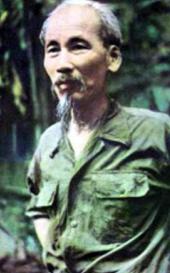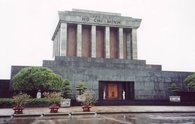Ho Chi Minh
|
|
Hồ Chí Minh (Chữ Nôm:胡志明)Template:Audio (May 19, 1890 – September 2, 1969) was a Vietnamese revolutionary and statesman, who later became Prime Minister (1954) and President (1954 - 1969) of North Vietnam.
He was originally named Nguyễn Sinh Cung, is also known as Nguyễn Tất Thành, Nguyễn Ái Quốc (a name used by other individuals as well), Lý Thụy, Hồ Quang (among others) and is popularly called Bác Hồ (uncle Hồ) in Vietnam.
| Contents |
Biography
Hồ was born in Hoang Tru and grew up in Kim Lien, Nam Dan District, Nghe An Province, Vietnam. Following Confucian traditions, he received the name Nguyễn Tất Thành at age 10. Hồ had two siblings, his brother Nguyen Tat Dat (or Ca Khiem), a geomancer and traditional herbalist and his sister Bach Lien (or Thanh) who worked as a clerk in the French Army. His father was convicted after he killed a friend after a drink session. Afraid of repercussions from the Authorities, Hồ went into hiding.
His father, Nguyễn Sinh Sắc was a Confucian scholar, and Hồ himself received a strong Confucian upbringing. He also received a modern secondary education at a French-style Lycee in Hue, the same alma mater of his later disciples, Pham Van Dong and Vo Nguyen Giap. Hồ wanted to work for the French colonialists. He made an application form for a course at the French "Colonial Administrative School" which Hồ filled out right after he arrived in Marseilles. This document is still preserved at the National Archives of France. Historian Nguyen The Anh has photocopied and published it in his book. After his application was rejected, Hồ built up anger against France. Hồ embraced Communism while living abroad in England (where he trained as a pastry chef under Escoffier) as well as France from 1915 - 1923.
Following World War I, as Nguyễn Ái Quốc, he petitioned the great powers at the Versailles peace talks for equal rights in French Indochina but was ignored. He asked the U.S. President at the time Woodrow Wilson for help to overthrow the French in Vietnam and to have a free democratic government like the French, but was again denied. He soon helped form the French Communist Party and spent much time in Moscow. He later moved to Guangzhou, China, where he founded the Vietnamese Communist Party.
Ho-Chi-Minh.jpg
After adopting the name Hồ Chí Minh (胡 志明), a Sino-Vietnamese name of a common surname (Hồ) and a given name meaning aspiring (Chí) to light (Minh), he returned to Vietnam in 1941 to lead the Viet Minh independence movement, conducting successful military actions against the Japanese occupation forces and later against the French bid to reoccupy the country (1946-1954). Hồ Chí Minh became President of the Democratic Republic of Vietnam (North Vietnam) in 1954 (he had declared himself President on March 2, 1946 but this was not recognised internationally), when he forced Emperor Bao Dai to abdicate.
He signed an agreement with France which recognized Vietnam as an autonomous state in the Indochinese Federation and the French Union on March 6, 1946 but that compromise did not prevent the war that begun that December between Hồ's forces and the French who tried to re-establish their colonial rule in the country; following the Chinese withdrawal from the North in exchange for French-occupied territories in China. Hồ was almost captured by a group of French Soldiers Lead by Jean-Etienne Valluy at Viet Bac, but he was able to slip into a camouflaged hole at the last minute.
He was a leading force in trying to re-unite North Vietnam with South Vietnam through infiltration and insurrection during the 1960s. Hồ led the war against the French (1946-1954) and, later, against the United States until his death. During his presidency, North Vietnam attempted disastrous agrarian reforms that resulted in tens of thousands of deaths, as landowners were publicly denounced as landlords and executed (he later repudiated these programs). In 1956, his government also suppressed a literary movement calling for more democracy and openness which resulted in at least 6,000 deaths.
During his presidency, Hồ was the center of a large personality cult in North Vietnam which increased in force after his death and when the former capital of South Vietnam, Saigon (Sàigòn), was captured it was renamed Hồ Chí Minh City within 24 hours.
To his supporters Hồ Chí Minh is viewed positively as a committed Nationalist and Vietnamese Communist, who fought for a united Vietnamese state. His opponents, however, feel that he was not an admirable figure, because he mandated the invasion of South Vietnam that resulted in the deaths of over a million of its citizens. His government was also considered to be totalitarian and oppressive.
The Communist government's official statement is that Hồ led a bachelor life, but it has been reported by the Far Eastern Economic Review that he may have been married at least twice, both times to French women, and may even have fathered a child.
Hồ died on the late evening of September 2, 1969 at his home in Hanoi at age 79 from multiple health problems including diabetes. His embalmed body was put on display in a granite mausoleum modeled after Lenin's Tomb in Moscow. This was consistent with other Communist leaders who have been similarly displayed before and since, including Mao Zedong, Kim Il-Sung, and for a time, Josef Stalin, but the "honor" violated Hồ's last wishes. He wished to be cremated and his ashes buried in urns on three Vietnamese hilltops, each in one of the three main regions of Vietnam (North, Central and South). He wrote, "Not only is cremation good from the point of view of hygiene, but it also saves farmland."
In Vietnam today, he is elevated by the Communist government to an almost cult-like status. He is invariably referred to as "Uncle Ho" at schools and universities. In all fairness however, it should be noted that Vietnamese who do not approve of Ho Chi Minh use his name with bathroom connotations: when one pays a "visit" to Uncle Ho one is expressing a need to use the bathroom. This, along with other colloquial allusions to the title "Uncle Ho", are frequently used among vietnamese refugees. Ho Chi Minh appears on the Vietnamese currency, and his image dominates much of the public space in Vietnam.
Quotes
- "Nothing is more precious than Independence and Liberty."
- "You can kill ten of my men for every one I kill of yours. But even at those odds, you will lose and I will win."
- "It is better to sacrifice everything than to live in slavery"
- "If the Tiger does not stop fighting the Elephant, the Elephant will die of exhaustion." (referring to Vietnam War)
- The Vietnamese people deeply love independence, freedom and peace. But in the face of United States aggression they have risen up, united as one man."
- "In (Lenin's Theses on the National and Colonial Questions) there were political terms that were difficult to understand. But by reading them again and again finally I was able to grasp the essential part. What emotion, enthusiasm, enlightenment and confidence they communicated to me! I wept for joy. Sitting by myself in my room, I would shout as if I were addressing large crowds: "Dear martyr compatriots! This is what we need, this is our path to liberation!" Since then (the 1920s) I had entire confidence in Lenin, in the Third International!"
Further reading
- Richard Nixon, Reprint edition (November 1, 1987).No More Vietnam. Arbor House Pub Co.
- Bernard B. Fall, ed., 1967. Ho Chi Minh on Revolution and War, Selected Writings 1920-1966. New American Library.
- Francis Fitzgerald. 1972. Fire in the Lake: The Vietnamese and Americans in Vietnam. Little, Brown and Company.
- William J. Duiker. 2000. Ho Chi Minh: A Life. Theia.
- N. Khac Huyen. 1971. Vision Accomplished? The Enigma of Ho Chi Minh. The Macmillan Company.
External links
- VietNam's Independence and Ho Chi Minh (http://www.vietquoc.com/0007VQ.HTM)
- New York Times Obituary, May 19, 1969 (http://www.nytimes.com/learning/general/onthisday/bday/0519.html)
- TIME 100: Ho Chi Minh (http://www.time.com/time/time100/leaders/profile/hochiminh.html)
- Ummasking Ho Chi Minh (http://www.worldnewsstand.net/HoChiMinh.htm)
- Facts About Ho Chi Minh by his former Colonel (http://freelao.tripod.com/id42.htm)Bui Tin
- Ho Chi Minh Biography (http://www.spartacus.schoolnet.co.uk/VNhochiminh.htm) From Spartacus Educational
- Ho Chi Minh Archive (http://www.marxists.org/reference/archive/ho-chi-minh/index.htm) at Marxists.org.bg:Хо Ши Мин
de:Ho Chi Minh es:Ho Chi Minh eo:HO Chi Minh fr:Hô Chi Minh id:Ho Chi Minh it:Ho Chi Minh he:הו צ'י מין nl:Ho Chi Minh ja:ホー・チ・ミン no:Ho Chi Minh pl:Ho Chi Minh (polityk) fi:Ho Tši Minh sv:Ho Chi Minh vi:Hồ Chí Minh zh:胡志明



